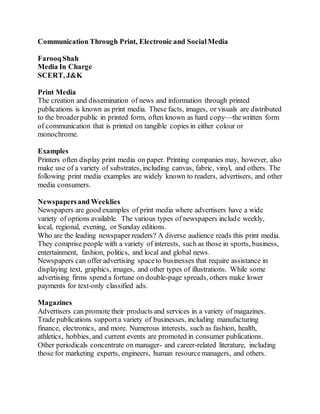PrintElectronicSocialMedia.docx
- 1. Communication Through Print, Electronic and SocialMedia FarooqShah Media In Charge SCERT, J&K Print Media The creation and dissemination of news and information through printed publications is known as print media. These facts, images, or visuals are distributed to the broaderpublic in printed form, often known as hard copyĪ¬thewritten form of communication that is printed on tangible copies in either colour or monochrome. Examples Printers often display print media on paper. Printing companies may, however, also make use of a variety of substrates, including canvas, fabric, vinyl, and others. The following print media examples are widely known to readers, advertisers, and other media consumers. Newspapersand Weeklies Newspapers are good examples of print media where advertisers have a wide variety of options available. The various types of newspapers include weekly, local, regional, evening, or Sunday editions. Who are the leading newspaper readers? A diverse audience reads this print media. They comprise people with a variety of interests, such as those in sports, business, entertainment, fashion, politics, and local and global news. Newspapers can offer advertising spaceto businesses that require assistance in displaying text, graphics, images, and other types of illustrations. While some advertising firms spend a fortune on double-page spreads, others make lower payments for text-only classified ads. Magazines Advertisers can promote their products and services in a variety of magazines. Trade publications supporta variety of businesses, including manufacturing finance, electronics, and more. Numerous interests, such as fashion, health, athletics, hobbies, and current events are promoted in consumer publications. Other periodicals concentrate on manager- and career-related literature, including those for marketing experts, engineers, human resourcemanagers, and others.
- 2. Most magazines come out once a week, once a month, or once every three months. Advertisers can still purchase spaceto display advertisements, whether they are in colour or black & white. Billboards Print media such as billboards and posters allow advertisers to reach consumers who are on the go. They are often positioned outdoors and feature enormous prints and artwork. These banners assist advertisers influence customers close to the sales counters by being placed in strategic locations, such as close to malls. To reach larger audiences of potential customers, advertising agencies use billboards in public spaces like airports and train stations. These enormous boards' size makes it nearly difficult for anyone to miss the advertisement. Additionally, advertisers can change the text, slogans, or images on billboards at predetermined times by combining digital and traditional media. Communication Through Electronic Media Electronic media, which include radio and television, are media that disseminate your message via some sort of electronic device. TV is seen as having a big effect because it frequently draws tens of thousands or even millions of viewers. The lead periods are typically very short; if a television station receives your press release, your story will air in less than 24 hours. Radio typically has a less impact than television because fewer people will hear your tale and there won't be any visuals to accompanyit. As a result, you must create press releases for both of these media types that make the most of their respective platforms. Forexample, a press release for TV MUST have excellent visual potential (and be more than just a talking head), and a press release for radio MUST have an excellent soundscape(background noises that add to the story). An electronic media story's lifespan might be quite brief. Millions of people may see a 15 second news clip, yet it might never be repeated. Other forms of electronic communication can be achieved through Email, Blogging, videoconferencing, telex, voice mail, et al. SocialMedia This is the media that you use to distribute information from your own company online. It consists of other other sites as such as Facebook, Twitter, Instagram, and Pinterest. In contrast to conventional media, social media requires you to gradually
- 3. establish your own following rather than relying on a TV, radio, or newspaper to do so. Social media has incredibly quick lead periods (seconds for some news), and its trends and flows cannot be controlled. To target specialised interest groups, nevertheless, it can be very effectively used. To create buzz on social media, you must turn your hype into it. The greatest buzz is when your piece "goes viral," or when a lot of people read (or "click") the content and it seems to take on a life of its own. A tale you poston social media may be difficult to take down... therefore take great care!



